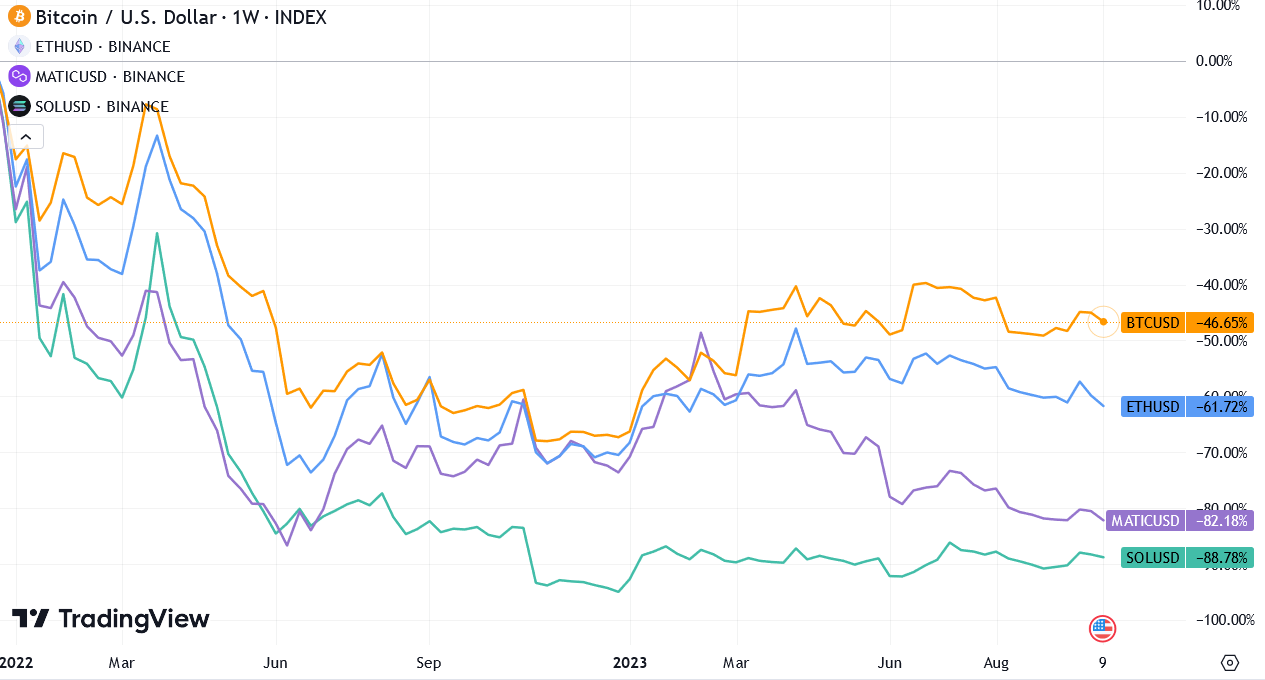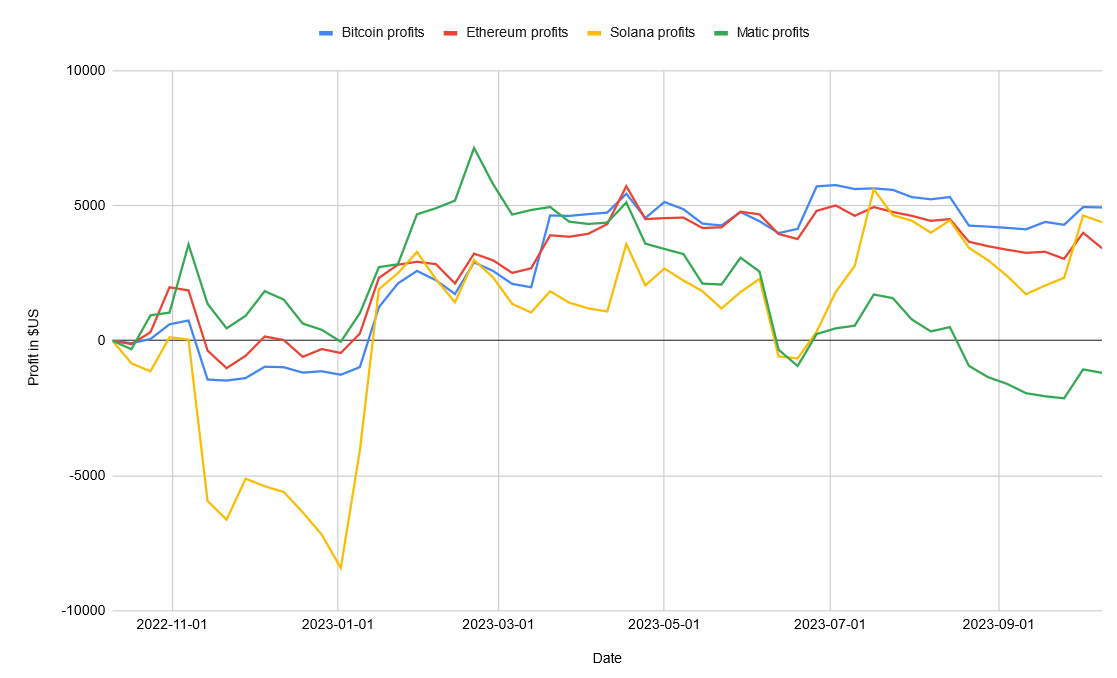“Having a good portfolio management strategy can set yourself up for long-term crypto investment success.” That sentence may sound cliche and overused, but it’s true. A good enough portfolio management strategy can give you an additional boost to your ROI, and you can even potentially “beat the market” like a good hedge fund does.
In this guide, we’ll explore a couple of portfolio management strategies for crypto investments. Wait, just a couple? Correct, these two strategies are so basic that if you follow them through, you’ll have the all the benefits that 90% of investors don’t get.
Portfolio management strategy is not “crypto picking”
Does a portfolio management strategy comes down to choosing the right projects? A good portfolio consists of projects that will likely to exist 10, 20, maybe 30 years down the line. It doesn’t have to be a crypto token that keeps going up, up and up. That’s impossible to find, unsustainable, and unrealistic.
The key to note is project survivability. A crypto token can go up and down in value, but it must continue to exist for as long as possible, so that you can profit from its crypto’s volatility. If you apply the right trading principles, you can profit from a token even if it goes sideways 10, 20 or even 30 years.
Four examples of potentially sustainable projects
For our sample portfolio management strategy, we need to simulate the prices and values of actual crypto, at least from the year to date. Luckily, we just need a few (say, four) high quality projects to start with — and we choose Bitcoin, Ethereum, Solana, and Polygon.
Bitcoin, the most secure cryptocurrency to date, is also the least volatile in the eyes of institutional investors, making it the perfect “novel asset” for beginners. Ethereum has a long history of active development and having an immense ecosystem of developers. It has shown to make continuous improvements in its design. Solana is currently Ethereum’s direct competitor, and as long as Ethereum still lags behind Solana in terms of technology, it remains a valuable project. Polygon is Ethereum’s helper network project that is also quite active for its kind.
While there isn’t a sure way to know if these projects will exist in 30 years’ time, they’re likely to exist for the next five years — and that is all the time that we need for now.
The conservative portfolio management strategy
To be conservative is to pay attention at potential maximum losses. Some crypto tokens are more prone to larger drops in prices than others, particularly during times of market uncertainty and when the “bear market traders” take over.
Of course, crypto tokens that are more prone to large price drops are also more prone to high price surges. Volatility often goes both ways, but for our conservative portfolio, we’d like to pay attention only to the risks.
The best way to look at relative risk levels of each crypto token is to compare their percentage changes in price over the same period. Luckily, TradingView allows us to do this quite easily. Pick Bitcoin (or any crypto of your choice) and click the Compare button next to it (a plus button in a round circle next to the ticker name) and compare it with ETHUSD, SOLUSD, and MATICUSD.
We’re also lucky enough to have seen two major bear markets, with the recent one being the end of 2022 directly after the collapse of FTX.

Unsurprisingly, Bitcoin holds its value with less volatility, at a maximum loss of 68% and holding on now at 46% of its December 2022 price. Ethereum comes second, unsurprisingly, and had experienced the worst crash at 73%, and now holding steady at 61%.
A surprising fact is that Polygon (MATIC) seems less volatile compared to Solana, despite Solana having a much larger market cap compared to the former. This has to do with FTX and its associates having a large stake in SOL tokens, which for a while, made it less attractive to hold after the exchange collapse.
From this quick analysis, we can have a feel for how much to invest into each asset. Someone who is more conservative may put four times as much in BTC as in SOL and MATIC, and roughly one-third less into Ethereum than they would into Bitcoin.
If this were the case, a $100,000 crypto portfolio would consist of 50% BTC, 30% ETH, and 20% in both SOL and MATIC combined.
This passive strategy ensures that your crypto portfolio can take losses at a reasonable amount that you’re comfortable with. And even if you have only put 10% into SOL, for example, you’ll never know how much of that will go up in price for the next bull run.
The rebalancing portfolio management strategy
The rebalancing portfolio management strategy is an active portfolio management strategy that makes use of your spare cash in order to increase your ROI. You can even combine this strategy with the one above to set your initial proportions of each crypto asset you’re most comfortable with based on their relative risks.
Rebalancing your portfolio is an active task, which means you must have spare cash to invest into more crypto when you need to. A common suggestion is to prepare at least 50% of your portfolio size in cash. This means, if you have a $100,000 crypto portfolio, you should have at least $50,000 in liquid cash, ready to seize the opportunity to buy more crypto when they’re cheaper.
Below will give you the details on how to do it, and we’ll show you how effective it is in a sideways market!
How to rebalance your crypto portfolio
The key to the rebalancing strategy is simple — keep your asset’s market value to its initial value. If you bought $10,000 of Bitcoin at $30,000, and next month its price falls to $21,000 (-30%), you need to buy $3,000 worth of Bitcoin at that price, to get your Bitcoin portfolio’s value back up to $10,000 at that price.
Then, if Bitcoin’s price goes back up to $30,000 from $21,000 (+42.8%), your $10,000 Bitcoin portfolio would actually now become $14,285. This is clearly more than $10,000, so you need to sell $4,285 worth of Bitcoin as per the rule.
Now, notice that you’ve made a small profit of $1,285 even if the price hadn’t gone above $30,000 (the initial Bitcoin price at the time we started to invest). In terms of ROI, we started with $10,000 with $5,000 of backup cash, and a profit of $1,285 — giving an ROI of 8.57%, which is quite decent.
Of course, if you wait further, Bitcoin’s price may go back down again, and in that case, you’d naturally reinvest your profit. In the long run, your reinvested profits will yield more profit, and in the end, you’d no longer need to worry about running out of liquid cash (the initial 50% that we talked about).
Use crypto trading signals, save time away from charts
Trade smart by following high quality crypto trading signals. Let professional quants and analyst study the price charts, giving you more time to manage your own portfolio. See the results yourself.
We’ve also supplied this guide with calculations on how effective this strategy is, considering the four crypto assets that we want to use — BTC, ETH, SOL, and MATIC. The data for this instance is the historical prices of the asset ranging from October 2022 to October 2023.

As you can see, because of volatility, the act of buying low and selling high in a sustainable and routine way create small but consistent profits that can make a big difference in the long run. Even when MATICUSD hasn’t performed as well as the others at the span of the year, there is potential for it to turn a profit as soon as another bull market runs, as you have accumulated cheaper MATIC.
Conclusion
Both portfolio management strategies — based on risk and based on rebalancing — can actually work in tandem to give you the best of both strategies. Of course, the key thing here is to abide by the same strategies consistently and without being influenced by the volatility of the moment.




